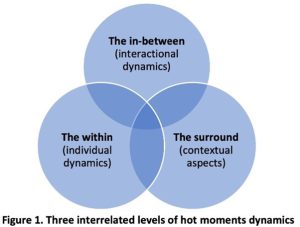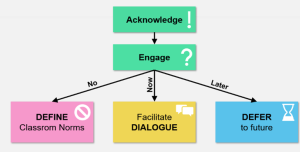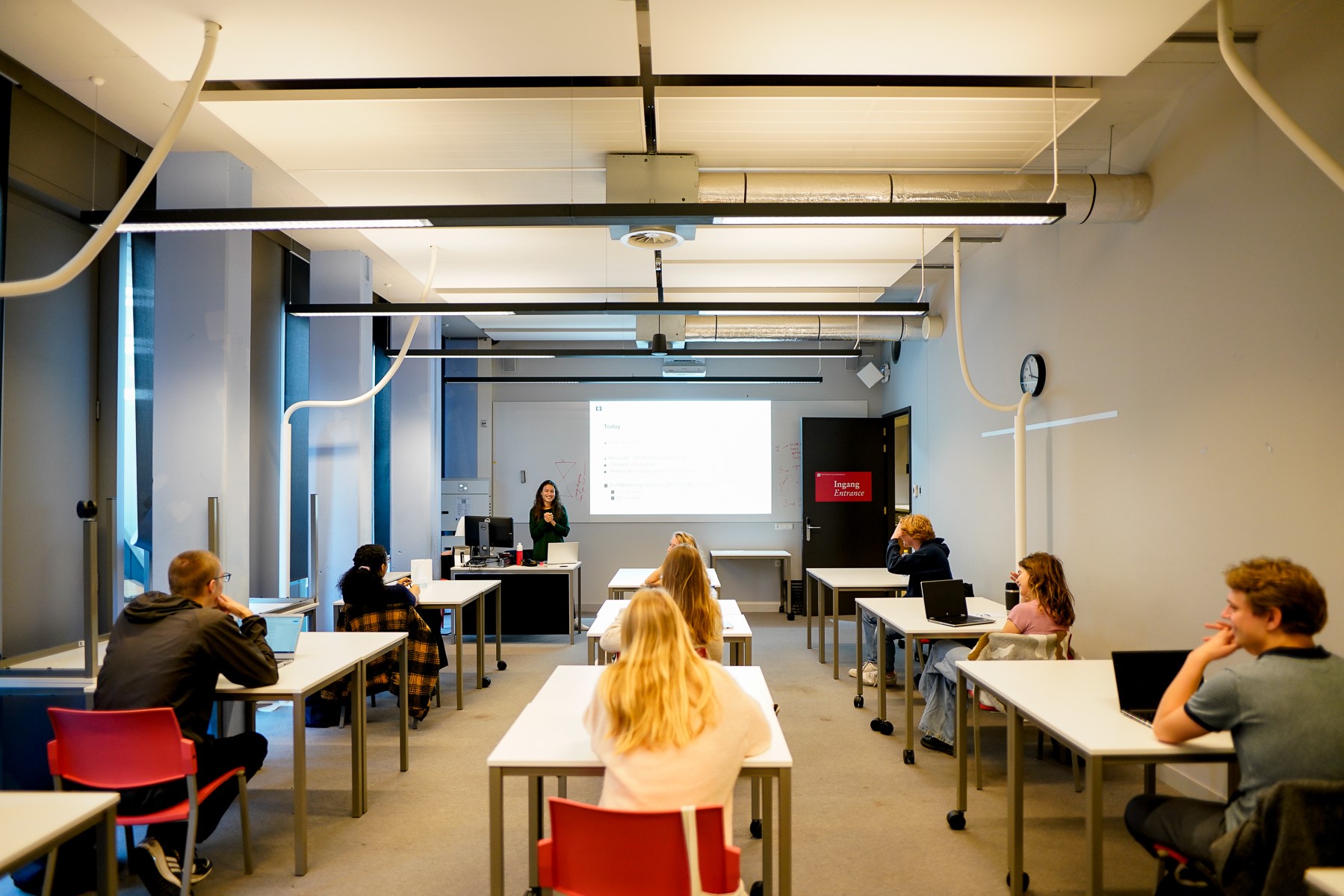
Recap: Knowledge sharing session on ‘HOT moments’
In times of conflicts around the world and an increasing degree of polarization in society, UvA teachers are more frequently encountering ‘HOT’ (Heated, Offensive and Tense) moments in the classroom. These are uncomfortable or unsafe situations where one person’s opinion clashes with another’s integrity. This can occur during discussions on sensitive topics, but also as a result of classroom dynamics. HOT moments have the potential to derail a lesson and cause harm to those involved. At the same time, a HOT moment can also be a valuable learning experience. Therefore, the Teaching & Learning Centre (TLC-Central) and the Central Diversity Office (CDO) jointly organized a knowledge-sharing session for teachers. In this session, various tips and tools were offered to turn HOT moments into enriching learning experiences. On this article page, you can read a report of the session, find the key tips and tools, and watch the recording of the session.
A written report of the knowledge-sharing session follows directly below. Do you want to watch the recording of the session? Or do you want to read the key tips directly? Then look at ‘Tips & tools’.
Recap of the HOT moments knowledge-sharing session
At SPUI25, UvA staff members from various functions and multiple faculties gathered for the knowledge-sharing session. Additionally, interested individuals who could not be physically present joined online. The session was organized on short notice, and to accommodate the interest, it was offered in a hybrid format. The interest in the session underscores the importance of the theme ‘HOT’ moments.
HOT moments occur when people’s emotions run so high that teaching and learning are threatened (Warren 2006). This can happen on 3 different levels, and sometimes HOT moments occur simultaneously on different levels (Ramdas et al., 2019).
- The within: the individual dynamics
- The in-between: the interactional dynamics
- The surround: the contextual aspects.
Setting ground rules for conducting discussions
It is therefore not a new concept, but teachers and other staff members are increasingly confronted with HOT moments. Yet the tools to adequately deal with these moments are often lacking. During this knowledge-sharing session, speakers Erjo Beitler (TLC-Central) and Machiel Keestra (CDO) aim to provide the attendees with the tools to respond to these tense moments. Erjo acknowledges that these situations present challenges for teachers: “We have clearly identified HOT moments as an important topic. Especially the development of the conflict between Israel and Hamas often creates such moments. A lot of emotions are involved, and everyone reacts differently. Some want to talk about it, while others do not. The goal of this session is to provide you with support in guiding heated discussions so that you can also support other colleagues in this.”
“We want to give everyone the opportunity to say something and ask that everyone listens carefully to each other.“
But before the session officially begins, Erjo and Machiel emphasize that an open and respectful atmosphere is essential for this session as well. “The topics are often sensitive, and we want to give everyone the opportunity to say something and ask that everyone listens carefully to each other,” Erjo explains. The chairs at the front of the room are arranged in a circle to create an ‘inner circle.’ Within this circle, everyone can look at each other and engage in real conversation. Erjo also sets some ground rules: “Before a discussion can take place, it is important that everyone knows what to expect and understands what is and is not acceptable in a discussion. This applies for today, but make sure to apply these rules in your classes as well.”
You can find the ground rules under Tips & Tools.
Institutional context surrounding HOT moments within the UvA

“That academic freedom of teachers within the classroom is based on scientifically obtained insights and thoroughly substantiated arguments.”
Machiel continues: “In order to somewhat regulate our handling as an academic community with events like these, you can also find information about academic freedom on the crisis page. This is also an important aspect in dealing with HOT moments. We, as UvA, want to take a neutral position to minimize the restriction of the academic freedom of individual teachers – and students – as much as possible.” “The academic freedom of teachers mainly applies to expertise within their own field,” Machiel elaborates. “That academic freedom of teachers within the classroom is based on scientifically obtained insights and thoroughly substantiated arguments. Additionally, we also have a code of conduct that we must adhere to within the UvA. Naturally, we want the campus to be a safe place for everyone at all times. Therefore, it is not intended for manifestations and demonstrations to take place within our buildings, but outside in the public space: otherwise, that academic freedom would be compromised. This goes beyond the behaviour of teachers and has an impact on the university as a whole. Sometimes, it is better not to take action during demonstrations to prevent escalations. In addition to an academic exchange, attention should also be paid to multiple perspectives – in this case, there should be room for contributions from both a Pro-Palestinian and a Pro-Israeli perspective.”
Find more about academic freedom and the facilities within the UvA in the slides of the PowerPoint presentation under Tips & Tools.
Personal experiences and tips from Erjo on dealing with HOT moments
In addition to the broader institutional context, the human aspects and personal experiences are especially important when it comes to sensitive issues. Erjo and Machiel take the time to share their own experiences and insights with the attendees. “I found it difficult to deal with HOT moments,” says Erjo. “Sometimes I would completely freeze and not know what to say. Others react very strongly when they disagree with something or when they feel a sense of injustice.”
“We want to create a safe learning environment with discomfort.”
Erjo emphasizes that it’s also okay to make mistakes: “It’s good to experiment and sometimes make mistakes. It’s impossible to always feel comfortable. We want to work towards a safe learning environment with discomfort. For this, it’s important to establish rules beforehand, together with students. This isn’t always easy, but you need to know that you can trust each other before discussing sensitive topics.” “Ask yourself what you want to achieve with a discussion. For many people, the first association is a TV debate where speakers try to convince each other, so it’s important to be able to formulate your opinion well. While in the classroom, it can be valuable to seek common ground and engage in dialogue. Then, it’s much more important to listen well. Be explicit with your students about the goals of the discussion and how those goals can be achieved.”
“Don’t be afraid to fail.”
Finally, Erjo explains that we need to acknowledge our differences and that we can use multiple forms of communication: “There are many inequalities between people, and it’s good to recognize them. Also, get to know yourself well and try to understand how you come across to your students. Use different ways to express yourself and communicate with students. Ultimately, it’s important that perspectives are acknowledged before you can delve into them. Always try to facilitate a dialogue and really don’t be afraid to fail. If emotions run too high or if there’s not enough time, you can always postpone a dialogue. Come back to it at another time; this also gives everyone time to reflect.”
You can find all of Erjo’s tips under Tips & Tools.
Personal experiences and tips from Machiel on dealing with HOT moments
When Machiel shares his personal experiences, he also underscores how important it is to acknowledge and discuss difficult topics. “If such topics are not discussed in the classroom, people feel ignored and excluded. This is extremely demotivating and even depressing. Dialogue is really important, but what we need to be careful of is forcing people to take sides in conflicts. This can lead to polarization, which is absolutely undesirable.” “So, it’s important once again that you really listen to people. Don’t ask them to take a position, but inquire about their personal experiences and emotions. The exchange and acknowledgment of personal and emotional struggles are possible without getting into political or historical discussions,” Machiel adds.
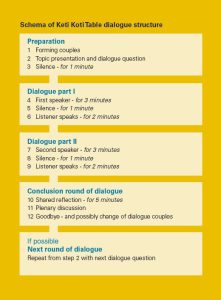
Machiel discusses further possibilities to facilitate the right dialogue and to create the right ‘space’: “You don’t want a culture of silence where people don’t speak up because they’re afraid of offending someone else. Therefore, try to create a ‘brave space’ where everyone is encouraged to speak up. However, everyone should express themselves with respect and empathy. Within this ‘brave space,’ people with different perspectives can engage in conversation. Sometimes they have very diverse experiences, which is also valuable. However, often similar emotions arise from different perspectives.”
“We have often received feedback, from students as well, that they had never had such an attentive and confidential conversation with an unfamiliar conversation partner.”
Machiel also provides tangible tools for discussing sensitive topics based on the Keti Koti Table, which he co-developed: “To facilitate a dialogue on Keti Koti (the abolition of slavery and its aftermath), we created a dialogue structure in advance. An important part of this structure is that everyone allows the speaker to finish, followed by an additional minute of silence to reflect before the listener responds. We have often received feedback, even from students, that they had never had such an attentive and confidential conversation with an unfamiliar conversation partner.”
“Art itself can certainly be controversial, but in my experience, art is also very valuable in addressing HOT moments.”
Machiel concludes with the power of art: “Do not limit the discussion of HOT moments to the usual academic topics and sources. It is also not always possible to have all the knowledge and illuminate all perspectives yourself. Various forms of art can help you with this. Art itself can of certainly be controversial, but in my experience, art is also very valuable in addressing HOT moments. Literature or film, for example, provide a good way to introduce a topic. Films from different parts of the world often succeed in highlighting those different perspectives and thus facilitating the dialogue we want.”
You can find all of Machiel’s tips under Tips & Tools.
Closure with an open dialogue
The knowledge-sharing session concludes with an open dialogue among the various attending teachers and other UvA staff members. They, in turn, openly share their personal experiences with HOT moments. These experiences vary, but the attendees agree that they often didn’t know how to handle these situations and that they didn’t feel good about them. This underscores the importance of the takeaways they say they gained from this session. “Today was very empowering for me, and I gained many helpful insights here. Some of the tips provided also include a few quick fixes that I can use and pass on to colleagues and students,” one attendee shares. Another adds, “I will definitely ensure there are breaks so everyone has time to reflect. Slowing down discussions by giving students homework on the topic and revisiting it later was a very good tip. I will also explore which art forms are suitable for homework assignments.”
“Ultimately, you can only create a safe environment if you also feel safe yourself.”
Finally, the attendees emphasize the importance of clear agreements and a safe environment. “If indeed you use the ground rules, you can always fall back on them if someone reacts inappropriately. This can then become a learning moment, and you can clearly explain why it was inappropriate. You can also involve others in explaining why something is inappropriate. Because if you feel something happening in the classroom, students will feel it even more. And ultimately, you can only create a safe environment if you also feel safe yourself.”
Tips&Tools
- The goal is to understand each other, not to persuade each other.
- Respect each others’ identities, perspectives and boundaries.
- What is discussed in the classroom, stays in the classroom.
- Do not interrupt each other.
- No personal attacks.
- Avoid generalizations.
- Assume good intentions.
- Establish clear rules for interaction together with your students.
- Create opportunities to get to know each other and build trust.
- Define your goals and expectations for discussions.
- Encourage active listening.
- Use different ways to express yourself.
- Learn to recognize (subtle) inequalities.
- Get to know yourself and how you come across.
- Use the ‘‘Oops, ouch’ technique’
- Take a breath and take it easy.
- Postpone your judgment.
- ‘Go to the balcony’ and create an overview.
- No response is also a response.
- HOT moments can be valuable learning opportunities.
- Try to read the subtext of comments.
- Take the burden of the issue off the student.
- Assign a written task.
- A dialogue ≠ a discussion.
- Do a ‘check-out’
All tips, tools and sources can be found in the presentation.

Machiel Keestra is a university lecturer and also a Diversity Officer of the UvA since February 2022. In this role, he advocates for equal rights, inclusion, and diversity within the university.
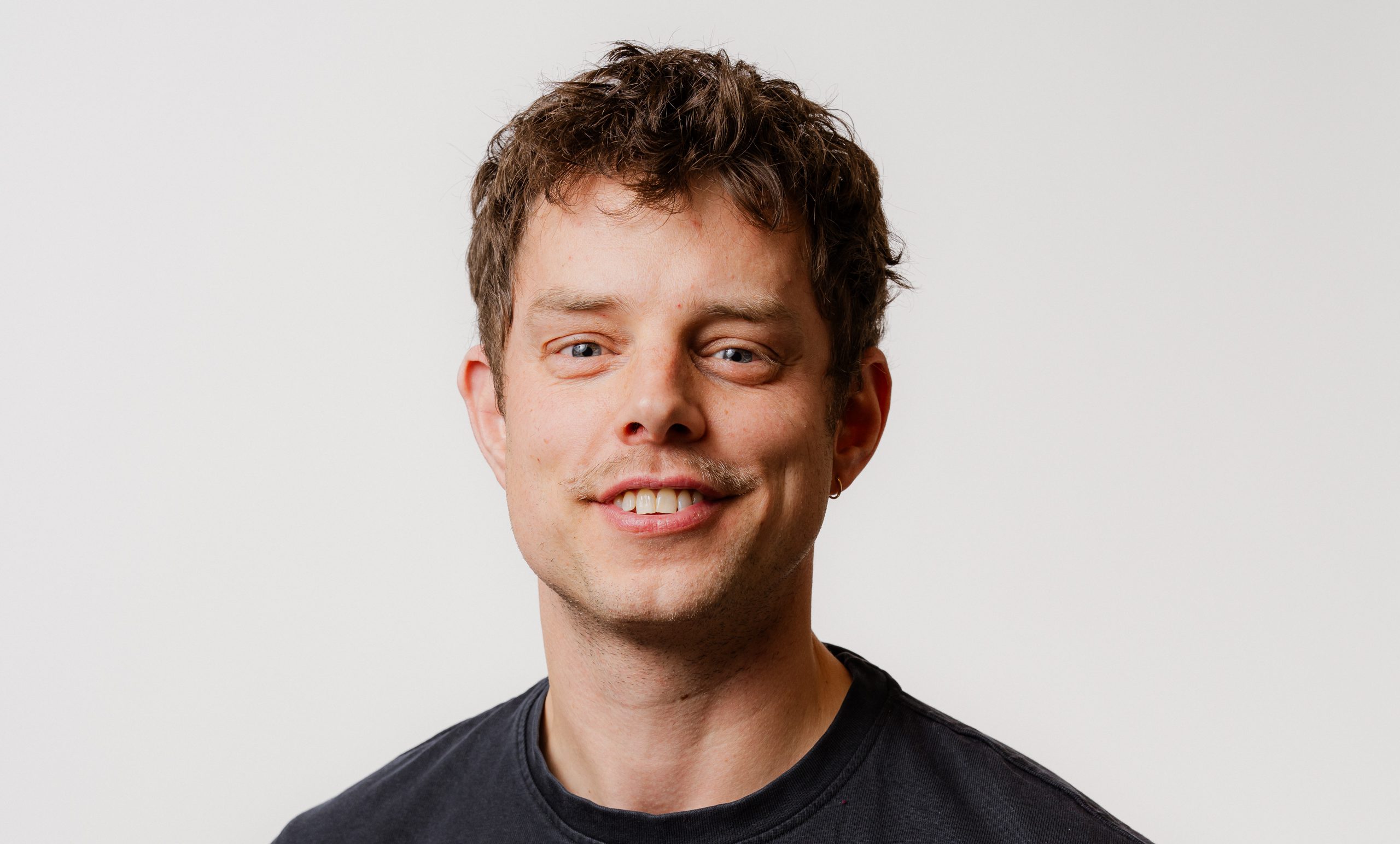
Erjo is a didactical advisor and trainer at TLC-Central. He provides UTQ* training to teachers and has gained a lot of experience with HOT Moments from his own teaching practice.
*University Teaching Qualification. Basiskwalificatie Onderwijs (BKO) in Dutch







